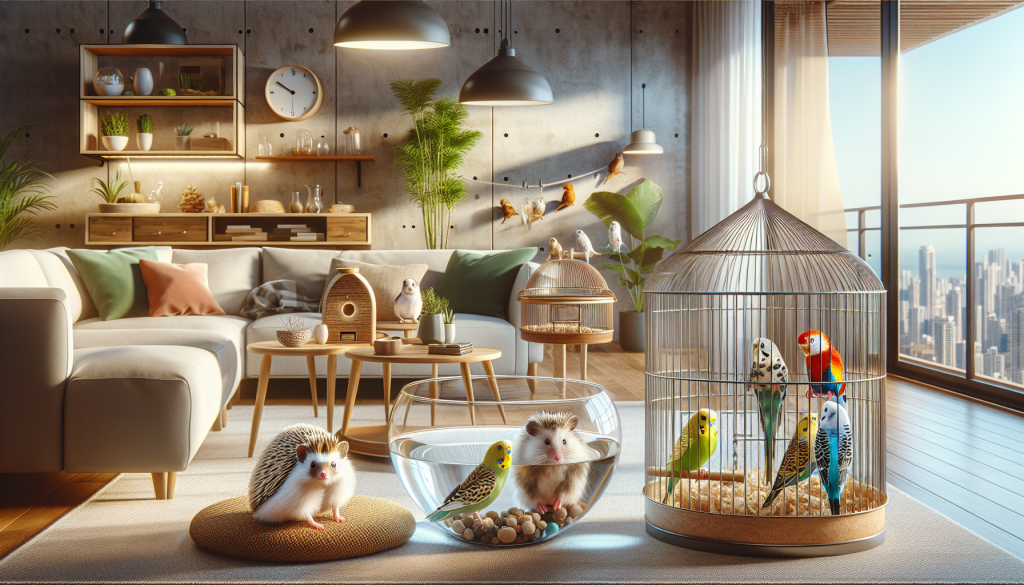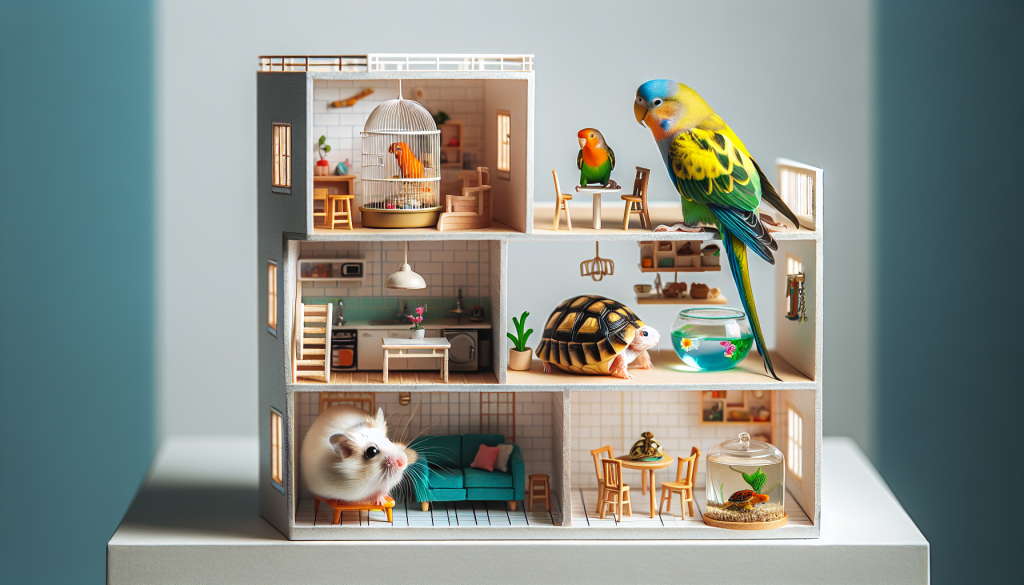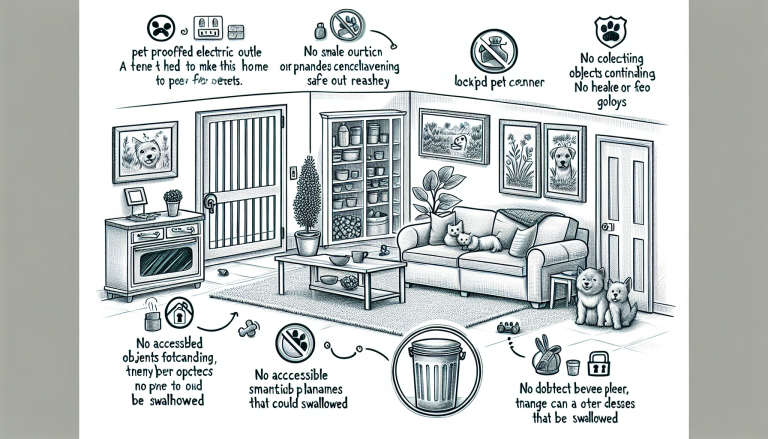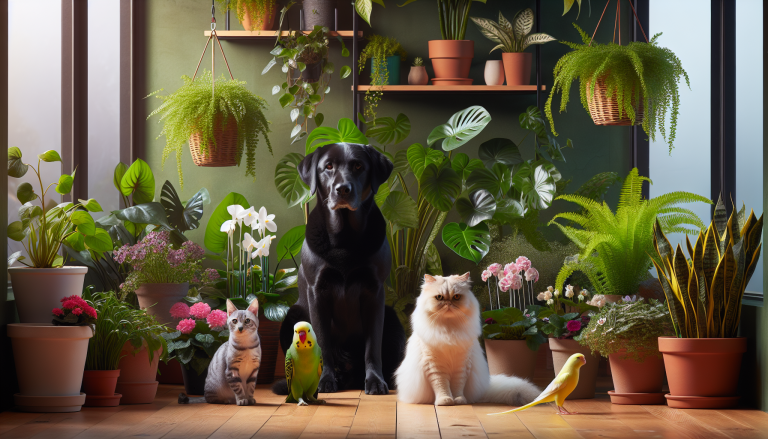If you’re living in an apartment and looking for a furry companion to keep you company, it can be overwhelming to choose from the variety of small pets available. Whether you’re a first-time pet owner or already have experience taking care of animals, selecting the right pet for your apartment lifestyle is crucial. In this article, we will explore the most popular small pets for apartment living, considering their size, temperament, and care requirements. By the end, you’ll have all the information you need to make an informed decision and find the perfect pet to share your apartment with.
Table of Contents
ToggleDogs
Benefits of having a dog in an apartment
Having a dog in an apartment can bring numerous benefits to your life. Firstly, dogs are known for their loyalty and companionship, providing a constant source of love and affection. Living in an apartment can sometimes feel lonely, but with a dog by your side, you’ll have a loyal, four-legged friend to keep you company and brighten your days.
Additionally, owning a dog can improve your physical and mental health. Dogs require regular exercise, so living in an apartment encourages you to go for daily walks, promoting a more active lifestyle. Walking your dog not only helps you stay fit but also allows you to explore your neighborhood and meet other pet owners.
Furthermore, dogs are excellent at reducing stress and anxiety. Their presence alone can help calm your nerves and provide a sense of comfort. Cuddling with your furry friend after a long day can instantly lift your mood and help you relax.
Best dog breeds for apartment living
Not all dog breeds are well-suited for apartment living, considering their size, exercise needs, and temperament. If you’re living in an apartment and considering getting a dog, here are some breeds that are known to thrive in smaller spaces:
-
French Bulldog: Known for their friendly and adaptable nature, French Bulldogs are perfect for apartment living. They are medium-sized dogs that don’t require excessive exercise and are comfortable in compact spaces.
-
Cavalier King Charles Spaniel: These gentle and affectionate dogs are well-suited for apartment living. With their moderate exercise needs and friendly temperament, they make great companions for apartment dwellers.
-
Pomeranian: Pomeranians may be small in size, but they have big personalities. They are energetic dogs that require regular exercise, but their small stature makes them suitable for apartments.
-
Shih Tzu: Shih Tzus are small, friendly, and adapt well to apartment living. They have moderate exercise needs and make great indoor pets due to their size and low-shedding coat.
-
Bichon Frise: Bichon Frises are small, cheerful, and highly adaptable dogs. They thrive in apartment environments and have a friendly nature, making them great companions.
Considerations before getting a dog in an apartment
Before bringing a dog into your apartment, it’s important to consider certain factors to ensure you and your furry friend have a happy and harmonious living arrangement.
Firstly, evaluate the size of your apartment and whether it can comfortably accommodate a dog. Some larger dog breeds, such as Great Danes or Mastiffs, may not have enough space to move around freely. Consider the size of your living room, availability of outdoor space, and easy access to walking areas.
Another important factor to consider is the dog’s exercise needs. While certain breeds are better suited for apartment living, all dogs require regular physical activity. Ensure you have enough time and commitment to provide daily walks, playtime, and mental stimulation for your dog.
Additionally, consider any restrictions imposed by your apartment complex or landlord. Some apartments have breed or size restrictions, so be sure to check the pet policies before getting a dog. Moreover, familiarize yourself with local regulations on dog ownership, such as leash laws and waste disposal requirements.
Lastly, remember that owning a dog is a long-term commitment. Dogs require care, attention, and financial responsibility. Ensure you have the time and resources to provide for your dog’s well-being, including food, grooming, veterinary care, and training.
Cats
Advantages of having a cat in an apartment
Bringing a cat into your apartment can offer numerous advantages. Cats make great apartment pets due to their independent nature and lower exercise requirements compared to dogs. Here are some benefits of having a cat in an apartment:
-
Low space requirements: Cats are known for their agility and ability to adapt to small spaces. They can comfortably roam around your apartment without feeling confined, making them perfect for apartment living.
-
Relaxing presence: Cats are incredibly calming animals. Their gentle purring and soothing presence can provide stress relief and help create a peaceful environment in your apartment.
-
Low maintenance: Cats are relatively low-maintenance pets, especially when compared to dogs. They are highly independent and can entertain themselves for hours. Additionally, cats are fastidious groomers and typically require minimal bathing and grooming.
-
Companionship: Although cats are independent creatures, they also form strong bonds with their owners. They can be loving and affectionate companions, providing you with the company you need without the constant need for attention.
-
Pest control: Living in an apartment can sometimes attract unwanted pests, such as mice or insects. Cats are natural hunters and can help keep these pests at bay, providing an added advantage to apartment dwellers.
Popular cat breeds for apartment living
When choosing a cat breed for apartment living, there are certain factors to consider, such as size, activity level, and temperament. Here are some cat breeds known to thrive in apartment environments:
-
Russian Blue: Russian Blues are renowned for their gentle and reserved nature. They are quiet, affectionate cats that adapt well to apartment living. With their beautiful blue coat and tranquil demeanor, they make excellent companions.
-
Ragdoll: Ragdolls are large, docile cats that enjoy living indoors. They are known for their affectionate and relaxed nature, making them ideal for apartment dwellers seeking a cuddly companion.
-
British Shorthair: British Shorthairs are sturdy and easygoing cats that adapt well to indoor living. They have a calm and gentle temperament, making them well-suited for apartment environments.
-
Maine Coon: Despite their large size, Maine Coons are surprisingly adaptable cats. They are sociable and friendly, enjoying the company of their owners. Their playful and affectionate nature makes them great companions for apartment living.
-
Siamese: Siamese cats are known for their vocal nature and playful personalities. They are intelligent and active cats that thrive in stimulating indoor environments, making them suitable for apartment living with proper mental stimulation and playtime.
Things to consider when adopting a cat for an apartment
Before adopting a cat for your apartment, consider the following factors to ensure a smooth transition and a happy living arrangement:
Firstly, ensure your apartment allows cats or any restrictions on the number or breed of cats allowed. Some apartments may have limits on the number of pets or specific breed restrictions, so it’s important to clarify this beforehand.
Consider the size of your apartment and whether it can accommodate a cat comfortably. Cats need space to move around, stretch, and play. Evaluate the availability of vertical spaces, such as cat trees or shelves, which provide additional exercise and territory.
If you plan on keeping your cat exclusively indoors, create an environment that stimulates their natural instincts. Provide scratching posts, interactive toys, and perches to keep them physically and mentally engaged. Consider investing in a litter box with odor control features to minimize any potential smell in your apartment.
Additionally, cats require a safe and enriching environment. Ensure windows and balconies are secured to prevent accidents or escapes. Remove any hazardous plants or objects that may pose a danger to your cat’s well-being.
Lastly, understand that cats require social interaction and mental stimulation. Spend quality time with your cat, engage in play sessions, and offer affection and companionship. If you have a busy schedule, consider adopting a pair of cats to provide companionship for each other.
Birds
Benefits of owning a bird in an apartment
Owning a bird in an apartment can bring a unique set of benefits. Birds are highly intelligent and sociable creatures that can provide companionship and entertainment. Here are some advantages of owning a bird in an apartment:
-
Compact size: Birds come in various sizes, allowing you to choose a species that suits your apartment’s space constraints. Smaller bird species require less space and can comfortably live in a compact cage or aviary.
-
Vocal companionship: Birds are known for their ability to mimic sounds and communicate with their human companions. Their cheerful chirping and melodic songs can brighten up your apartment and create a pleasant atmosphere.
-
Low maintenance: Compared to other pets, birds require relatively low maintenance. Once you provide them with a clean and suitable habitat, they can live happily with regular food and water replenishment.
-
Lifelong bond: Birds are highly social animals and can form deep bonds with their owners. With time and patience, you can develop a strong connection and enjoy the company of your feathery friend for many years.
-
Educational: Owning a bird offers a unique opportunity to learn about avian behavior, biology, and communication. Birds are intelligent creatures, and observing their natural behaviors can be a fascinating experience.
Popular small bird species for apartment living
If you’re considering getting a bird for your apartment, here are some popular small bird species known to adapt well to apartment environments:
-
Budgerigar (Budgie): Budgies are small, colorful parakeets that make fantastic apartment pets. They are easy to care for, highly sociable, and can be taught to mimic words or phrases.
-
Canary: Canaries are known for their beautiful singing abilities. They are relatively low-maintenance birds and are available in various colors and breeds. Canaries enjoy singing their melodious tunes, bringing a cheerful ambiance to your apartment.
-
Lovebird: Lovebirds are small, intelligent parrots known for their affectionate nature. They thrive on social interaction and form strong bonds with their owners. Lovebirds have vibrant plumage and can provide endless entertainment with their playful personalities.
-
Finch: Finches are small songbirds that are well-suited for apartment living. They are low-maintenance, and their melodious chirping can create a calming environment in your apartment. Finches are available in various species and colors, allowing you to choose the one that appeals to you.
-
Cockatiel: Cockatiels are popular pet birds due to their friendly and sociable nature. They can be trained to mimic sounds and voice commands, making them excellent companions. Cockatiels require mental stimulation and attention, but they can adapt well to apartment environments.
Specific care requirements for apartment-dwelling birds
When bringing a bird into your apartment, it’s crucial to provide them with a suitable habitat and meet their specific care requirements. Here are some important considerations for apartment-dwelling birds:
-
Cage size and placement: Choose a cage that is appropriately sized for your bird species. Birds need to have enough space to flap their wings and move freely. Place the cage in an area where the bird can interact with you and observe their surroundings without feeling isolated.
-
Social interaction: Birds are social animals and require regular interaction and mental stimulation. Spend time talking, singing, and playing with your bird daily. Offer them toys, puzzles, and foraging opportunities to keep their minds engaged.
-
Proper nutrition: Provide a balanced diet consisting of commercial bird pellets, fresh fruits, vegetables, and occasional treats. Research the specific dietary needs of your bird species to ensure you’re providing the right nutrients for their overall well-being.
-
Environmental enrichment: Birds need a stimulating environment to prevent boredom and stress. Offer perches of different sizes and textures, safe toys for chewing and exploring, and a suitable bathing area for hygiene purposes. Rotate toys regularly to keep them entertained.
-
Quiet time: Birds require a consistent sleeping and resting schedule. Ensure your apartment provides a quiet and calm environment during the bird’s designated sleep hours. Avoid loud noises, sudden changes in lighting, or disturbances that may disrupt their sleep patterns.
Remember to regularly monitor your bird’s health, provide them with a clean living environment, and seek veterinary care if any concerns arise. With proper care, attention, and love, owning a bird can be a rewarding experience in your apartment.
Fish
Advantages of having fish in an apartment
Bringing fish into your apartment can have several advantages that add beauty and tranquility to your living space. Here are some benefits of having fish in an apartment:
-
Soothing ambiance: Watching fish in a well-maintained aquarium can create a calming and serene atmosphere in your apartment. The slow movement and vibrant colors of the fish can help reduce stress and promote relaxation.
-
Low space requirements: Fish tanks come in various sizes, allowing you to choose one that fits your apartment’s available space. Even in smaller tanks, you can create an underwater world for your fish to thrive in.
-
Low maintenance: Compared to other pets, fish are relatively low maintenance. Once you establish the right environment in the tank, regular feeding and occasional water parameter checks are typically all that is required.
-
Educational: Owning fish provides a unique opportunity to learn about aquatic ecosystems, different fish species, and the intricacies of maintaining a healthy aquarium. It can be an educational and engaging hobby that brings a sense of fulfillment.
-
Natural artistry: Aquariums can be considered living artworks. With carefully chosen decor, plants, and fish species, you can create a visually stunning centerpiece in your apartment. It can be a source of pride and a conversation starter when guests visit.
Suitable fish species for small apartment tanks
Not all fish species are suitable for small apartment tanks. Here are some fish species known to thrive in smaller tanks and adapt well to apartment living:
-
Betta Fish: Betta fish, also known as Siamese fighting fish, are popular for their vibrant colors and flowing fins. They are relatively small and can comfortably live in smaller tanks. Betta fish are known for their resilience and ability to survive in various water conditions.
-
Guppies: Guppies are small, colorful fish that are easy to care for and perfect for beginners. They are adaptable and can thrive in smaller tanks. Guppies come in various colors and patterns, adding visual interest to your aquarium.
-
Neon Tetras: Neon Tetras are small, peaceful fish known for their bright blue and red coloration. They are shoaling fish, so it’s recommended to keep them in groups of at least six. Neon Tetras can bring vibrant liveliness to your apartment tank.
-
Dwarf Gouramis: Dwarf Gouramis are small, labyrinth fish with beautiful and vibrant patterns. They are relatively easy to care for and can adapt well to smaller tanks. Dwarf Gouramis can add a touch of elegance to your aquarium.
-
Corydoras Catfish: Corydoras Catfish are small and peaceful bottom-dwelling fish. They come in various species, each with its unique coloration and pattern. Corydoras Catfish are known for their cleaning abilities, effectively keeping the tank substrate clean.
Maintenance tips for apartment fish tanks
To ensure a healthy and thriving aquarium in your apartment, consider the following maintenance tips:
-
Water quality: Monitor and maintain proper water parameters such as temperature, pH, ammonia, nitrite, and nitrate levels. Regularly test the water and perform partial water changes to keep the aquarium environment stable and healthy for your fish.
-
Filtration: Choose an efficient filter suitable for the size of your tank. Filters help remove debris, toxins, and maintain good water circulation. Regularly clean and maintain the filter to ensure optimal performance and a clean environment for your fish.
-
Feeding: Feed your fish a balanced diet suitable for their species. Overfeeding can lead to poor water quality and health issues. Observe your fish’s feeding behavior and adjust the amount and frequency of feedings accordingly.
-
Aquarium decor: Choose appropriate decorations and plants for your aquarium. Some fish species require hiding spots or vegetation to feel secure. Ensure the decor is properly cleaned and free from sharp edges or chemicals that may harm the fish.
-
Lighting: Provide appropriate lighting for your aquarium, considering the needs of the fish and any live plants. Maintain a consistent lighting schedule to simulate day and night cycles, allowing your fish to establish natural behavior patterns.
-
Monitor fish health: Regularly observe your fish for any signs of illness or stress. Look out for changes in behavior, appetite, or physical appearance. If you notice any abnormalities, seek veterinary advice or consult with an experienced fish enthusiast.
By following these maintenance tips and dedicating regular time to care for your fish, you can create a thriving and visually captivating aquarium in your apartment.
Hamsters
Benefits of owning a hamster in an apartment
Owning a hamster in an apartment can be a delightful experience. Hamsters are small, adorable creatures that can bring joy and entertainment to your living space. Here are some benefits of owning a hamster in an apartment:
-
Compact size: Hamsters are small and require relatively little space compared to larger pets. They can comfortably live in specially designed cages that fit well in apartments, requiring minimal floor space.
-
Low noise level: Hamsters are generally quiet pets, making them well-suited for apartment living. Unlike dogs or cats, they don’t typically vocalize loudly or disturb neighbors, creating a peaceful environment.
-
Low maintenance: Hamsters are relatively low-maintenance pets. They are independent creatures that can entertain themselves for hours with their various toys and activities. Regular feeding, cleaning, and interaction are all that’s typically required.
-
Entertainment value: Watching hamsters scurry around their cage, explore tunnels, and enjoy their favorite treats can be highly entertaining. Their playful and curious nature provides endless amusement.
-
Bonding opportunities: Hamsters can form strong bonds with their owners with regular interaction and gentle handling. They may become the highlight of your day as you spend quality time together and form a unique connection.
Popular hamster breeds suitable for apartments
When choosing a hamster breed for apartment living, it’s essential to consider their specific needs and temperaments. Here are some popular hamster breeds known to adapt well to apartment environments:
-
Syrian Hamster: Syrian Hamsters, also known as Golden Hamsters, are the most common pet hamster breed. They are generally larger in size and have a more solitary nature, making them suitable for individual apartments.
-
Dwarf Hamster: Dwarf Hamsters, including Campbell’s Dwarf, Winter White Dwarf, and Roborovski Dwarf, are smaller in size and highly sociable. They are active, curious, and can provide endless entertainment in their cage.
-
Chinese Hamster: Chinese Hamsters are small, agile creatures known for their friendly nature. They are relatively low-maintenance pets suitable for apartments. Chinese Hamsters are known for their ability to entertain themselves with various toys and activities.
-
Russian Campbell Dwarf: Russian Campbell Dwarf Hamsters are energetic and sociable pets. They thrive on social interaction and require plenty of mental and physical stimulation. With their playful personalities, they can make excellent companions in an apartment setting.
-
Roborovski Dwarf: Roborovski Dwarf Hamsters are the smallest hamster breed and known for their agility and speed. They require spacious cages and plenty of exercise opportunities. Roborovski Hamsters can be a fascinating addition to your apartment space.
Necessary setup and care tips for apartment hamsters
To ensure a comfortable and healthy environment for your hamster in your apartment, consider the following setup and care tips:
-
Cage and bedding: Choose a suitable cage that provides enough space for your hamster to move around, exercise, and burrow. Line the bottom of the cage with safe bedding material, such as aspen shavings or paper-based bedding.
-
Enrichment activities: Provide your hamster with a variety of toys, tunnels, and chewable items to keep them stimulated and entertained. Hamsters are active creatures that require mental and physical exercise.
-
Proper nutrition: Offer a balanced diet consisting of commercial hamster pellets, grains, fresh fruits, and vegetables. Avoid giving them foods that are toxic to hamsters, such as chocolate, onions, or garlic. Provide fresh water daily in a spill-proof water bottle.
-
Hygiene and cleaning: Regularly clean your hamster’s cage, removing any soiled bedding, uneaten food, or waste. Clean the cage using a pet-safe disinfectant to prevent the buildup of bacteria or other harmful organisms. Spot clean the cage daily to maintain cleanliness.
-
Handling and interaction: Gently handle and interact with your hamster to build trust and create a bond. Hamsters are delicate creatures, so ensure you handle them with care and avoid sudden movements. Offer treats and toys during playtime to create positive associations.
-
Environmental considerations: Place the hamster cage in a quiet and well-ventilated area of your apartment, away from direct sunlight and drafts. Maintain a consistent temperature between 65-75°F (18-24°C) to ensure your hamster’s comfort.
Remember to spend quality time with your hamster, observe their behavior, and seek veterinary care if any health concerns arise. With proper care and attention, owning a hamster can be a rewarding experience in your apartment.
Guinea Pigs
Advantages of having guinea pigs in an apartment
Guinea pigs can make wonderful pets for apartment living, providing companionship, entertainment, and a unique charm to your living space. Here are some advantages of having guinea pigs in an apartment:
-
Gentle nature: Guinea pigs are known for their friendly and gentle nature. They are generally docile and enjoy human interaction, making them great companions for apartment dwellers seeking affectionate pets.
-
Minimal noise: Guinea pigs are relatively quiet pets, emitting soft chirping sounds and occasional squeaks. They are unlikely to create noise disturbances in an apartment environment, allowing for a peaceful living space.
-
Conversation starters: Guinea pigs have a unique appearance and playful demeanor, often attracting attention and sparking conversations with visitors. Their presence can create a warm and welcoming atmosphere in your apartment.
-
Low maintenance: Guinea pigs are easy to care for and relatively low-maintenance pets. They require regular feeding, fresh water, and a clean living environment. With proper care, they can thrive in apartment settings.
-
Interactive pets: Guinea pigs enjoy human interaction and thrive when provided with mental stimulation. Spending time with your guinea pig, offering treats, and engaging in gentle play can create a bond and provide entertainment.
Best guinea pig breeds for smaller living spaces
When choosing a guinea pig breed for your apartment, it’s important to consider their temperament, size, and care requirements. Here are some guinea pig breeds known to adapt well to smaller living spaces:
-
American Guinea Pig: American Guinea Pigs are the most common breed and a popular choice for apartment living. They have a gentle nature and generally adapt well to indoor environments.
-
Peruvian Guinea Pig: Peruvian Guinea Pigs are known for their long, flowing hair. Despite their luxurious coats, they are suitable for apartment living. Regular grooming and proper hygiene are important for their well-being.
-
Abyssinian Guinea Pig: Abyssinian Guinea Pigs have unique coats that form rosettes all over their bodies. They are friendly and active, making them great companions for apartment dwellers looking for an interactive pet.
-
Teddy Guinea Pig: Teddy Guinea Pigs are known for their dense and long fur, resembling a stuffed teddy bear. They are generally calm and sociable, thriving in environments with gentle interaction and regular care.
-
Short-Haired Guinea Pig: Short-haired guinea pigs, such as the Smooth and Satin breeds, have short, low-maintenance coats. They are easy to care for and adapt well to apartment living.
Important considerations for apartment guinea pig care
To ensure the well-being of your guinea pigs in your apartment, consider the following important care considerations:
-
Cage size: Guinea pigs need ample space to move around, exercise, and explore. Provide a suitable cage that allows at least 7.5 square feet (0.7 square meters) of space per guinea pig. Choose a cage with solid flooring to prevent injuries.
-
Bedding and hygiene: Use guinea pig-friendly bedding materials, such as aspen shavings or paper-based bedding, to line the cage. Spot-clean the cage daily and perform a thorough cage cleaning weekly to maintain cleanliness and prevent odor.
-
Proper nutrition: Guinea pigs have specific dietary needs and require a balanced diet consisting of hay, fresh vegetables, and commercial guinea pig pellets. Ensure a constant supply of fresh water in a spill-proof water bottle.
-
Social interaction: Guinea pigs are social animals and require companionship. Consider getting at least two guinea pigs to prevent loneliness and provide a sense of security. Supervise interactions between guinea pigs and human family members, especially children, to ensure gentle handling.
-
Environmental comfort: Guinea pigs prefer moderate temperatures between 65-75°F (18-24°C). Avoid exposing them to extreme heat or cold. Place their cage away from drafts, direct sunlight, or areas prone to temperature fluctuations.
-
Enrichment and exercise: Provide guinea pigs with tunnels, hides, toys, and safe chewable items to encourage mental stimulation and physical exercise. Engage in gentle playtime and regular out-of-cage time in a safe and secure area.
Remember to observe your guinea pigs for any signs of illness, such as changes in appetite, behavior, or grooming habits. Seek veterinary care if any concerns arise. With proper care and attention, guinea pigs can thrive in apartment environments and bring joy to your living space.
Rabbits
Benefits of having rabbits in an apartment
Owning rabbits in an apartment can bring numerous benefits and add a unique charm to your living space. Here are some advantages of having rabbits in an apartment:
-
Playful and entertaining: Rabbits are known for their playful and mischievous nature, bringing entertainment and joy to your apartment. Watching them binky (joyful hopping), exploring, and interacting with their surroundings can be highly amusing.
-
Quiet companions: Rabbits are generally quiet pets, emitting soft purring or gentle thumping sounds to communicate. They are unlikely to create noise disturbances in your apartment, allowing for a peaceful living environment.
-
Bonding opportunities: Rabbits enjoy human interaction, and with time and patience, they can form strong bonds with their owners. Spending quality time with your rabbit, offering gentle petting, and engaging in playtime can create a deep connection.
-
Compact living requirements: Rabbits take up relatively little space and can adapt well to apartment living. They can comfortably live in cages or playpens and require additional supervised out-of-cage time for exercise.
-
Educational pets: Rabbits provide a unique opportunity to learn about their behaviors, grooming needs, and dietary preferences. Observing their natural habits and meeting their specific needs can be an educational and fulfilling experience.
Popular rabbit breeds suitable for apartment living
When choosing a rabbit breed for apartment living, consider their size, temperament, and care requirements. Here are some rabbit breeds known to adapt well to apartment environments:
-
Dwarf Hotot: Dwarf Hotots are small rabbits known for their distinct appearance with dark eye circles. They have a friendly and docile nature, making them suitable for apartment living.
-
Netherland Dwarf: Netherland Dwarfs are the smallest rabbit breed, making them ideal for apartments with limited space. They have a playful and sociable nature, enjoying human interaction and stimulation.
-
Lionhead: Lionhead rabbits have a distinctive fluffy mane-like fur around their head, resembling a lion’s mane. They are small to medium-sized, gentle-natured rabbits that thrive in apartment environments with proper care and attention.
-
Holland Lop: Holland Lops are small and compact rabbits known for their floppy ears. They have a friendly and sociable nature, making them a popular choice for apartment dwellers seeking a companionable pet.
-
Mini Rex: Mini Rex rabbits have soft, velvety fur and a playful nature. They are known for their intelligence and adaptability, thriving in smaller living spaces with regular interaction and mental stimulation.
Housing and care requirements for apartment rabbits
To ensure the well-being of your rabbits in your apartment, consider the following housing and care requirements:
-
Living space: Provide a spacious cage or playpen that allows ample room for your rabbit to move, stretch, and stand on their hind legs. Rabbits need enough space to exercise comfortably, even when confined to their living area.
-
Appropriate flooring: Use bedding material appropriate for rabbits, such as aspen shavings or paper-based bedding. Avoid using aromatic or toxic wood shavings. Place a litter box filled with litter pellets in the cage to encourage your rabbit to use one specific area for elimination.
-
Proper diet: Offer a balanced diet consisting of fresh grass hay, high-quality pellets, and a variety of fresh vegetables. Avoid feeding rabbits foods that are toxic to them, such as chocolate, onions, or garlic. Provide fresh water in a spill-proof bowl or water bottle.
-
Social interaction: Rabbits are social animals and require companionship, whether from humans or other rabbits. Consider getting at least two rabbits to provide social interaction and prevent loneliness. Supervise interactions between rabbits and human family members, especially children, to ensure gentle handling.
-
Environmental comfort: Rabbits are sensitive to extreme temperatures. Ensure they are kept in a cool and well-ventilated area, avoiding direct sunlight, drafts, or areas prone to temperature fluctuations. Provide a hiding spot or shade structure for their comfort.
-
Enrichment activities: Rabbits are intelligent animals that require mental stimulation and physical exercise. Provide toys, tunnels, and chewable items to keep them engaged. Allow supervised out-of-cage playtime in a designated, rabbit-proofed area to encourage exploration and exercise.
Remember to observe your rabbits for any signs of illness, changes in behavior, or grooming habits. Seek veterinary care if any concerns arise. With proper care, attention, and love, rabbits can thrive in apartment environments and bring a unique joy to your living space.
Reptiles
Advantages of owning a reptile in an apartment
Bringing a reptile into your apartment can offer unique advantages and provide a fascinating pet ownership experience. Here are some advantages of owning a reptile in an apartment:
-
Low space requirements: Reptiles, especially smaller species, require relatively little space compared to larger pets. They typically live in enclosures, such as terrariums or vivariums, which can fit well in apartment settings.
-
Quiet companions: Reptiles are generally quiet pets, not emitting sounds that may disturb neighbors in an apartment environment. Their subtle movements and intriguing behaviors can create a peaceful and calming living space.
-
Low maintenance: Compared to other pets, reptiles require relatively low maintenance. They typically have specific dietary needs and require suitable temperature and humidity conditions in their enclosure. Once the proper environment is set up, regular feeding, cleaning, and observation are usually all that is required.
-
Educational value: Reptiles provide a unique opportunity to learn about their natural habitats, behaviors, and specific care needs. Owning a reptile can be an educational experience, allowing you to appreciate the intricacies of these fascinating creatures.
-
Aesthetically intriguing: Reptiles come in various shapes, sizes, and colors, offering a visually intriguing addition to your apartment. Their unique scales, patterns, and movements can be a source of aesthetic pleasure and a conversation starter with guests.
Small reptile species suitable for apartment setups
When considering owning a reptile in your apartment, choose a species that is suitable for smaller living spaces. Here are some small reptile species known to adapt well to apartment setups:
-
Leopard Gecko: Leopard Geckos are small, docile lizards known for their stunning appearance and relatively low care requirements. They are easy to handle, have minimal space requirements, and can thrive in apartment environments.
-
Crested Gecko: Crested Geckos are small arboreal lizards that are becoming increasingly popular as pets. They are known for their unique fringed appearance and gentle nature. Crested Geckos require a vertically oriented enclosure and a moderate temperature range.
-
Anole: Anoles, specifically Green Anoles and Brown Anoles, are small, active lizards that can adapt well to apartment living. They require enclosures with climbing opportunities, access to UV lighting, and appropriate temperature and humidity levels.
-
Corn Snake: Corn Snakes are popular pet snakes known for their docile nature and relatively small size. They can comfortably live in apartment-sized enclosures that provide hiding spots and suitable temperature gradients.
-
Kenyan Sand Boa: Kenyan Sand Boas are small, burrowing snakes that thrive in a secure and appropriately sized enclosure. They require low humidity levels and are considered relatively low-maintenance reptile pets.
Temperature and space considerations for apartment reptiles
When housing reptiles in your apartment, it’s crucial to provide the appropriate temperature and space considerations. Here are some factors to consider for apartment living with reptiles:
-
Enclosure size: Choose an enclosure that provides enough space for your reptile to move, stretch, and engage in natural behaviors. Ensure the enclosure size is suitable for the specific reptile species you plan to keep. Research the adult size and habitat requirements to determine the appropriate enclosure size.
-
Temperature control: Reptiles have specific temperature requirements based on their natural habitats. Use thermometers and heating devices, such as heat pads or bulbs, to maintain the optimal temperature gradient within the enclosure. Ensure temperature fluctuations are minimal and consistent.
-
Lighting: Depending on the reptile species, ensure they have access to appropriate UV lighting. UVB lighting helps reptiles synthesize vitamin D, which is crucial for their overall health. Research the specific lighting requirements for your reptile species and provide suitable lighting fixtures.
-
Substrate selection: Choose appropriate substrate material for the reptile’s enclosure. Each species has different substrate preferences and requirements. Some may require natural substrates, such as soil or sand, while others may benefit from artificial options, such as reptile carpet or paper-based bedding.
-
Escape-proof enclosures: Ensure your reptile’s enclosure is secure and escape-proof. Reptiles have unique physical abilities, and it’s important to prevent any potential escapes or accidents. Regularly inspect the enclosure for any weaknesses or potential hazards.
Remember to familiarize yourself with the specific care requirements, feeding habits, and veterinary needs of your chosen reptile species. Seek professional advice or consult with experienced reptile owners if needed. Owning a reptile can be a rewarding experience in your apartment if you provide the proper environment and care.
Gerbils
Benefits of owning gerbils in an apartment
Gerbils can make wonderful pets for apartment living, providing companionship, entertainment, and a unique charm to your living space. Here are some benefits of owning gerbils in an apartment:
-
Compact size: Gerbils are small, adorable creatures that require relatively little space compared to larger pets. They can comfortably live in specially designed cages that fit well in apartments, requiring minimal floor space.
-
Interactive and entertaining: Gerbils are highly active animals known for their playful nature. They love to dig, burrow, and explore their environment. Watching them perform acrobatics, run on their wheels, and interact with each other can provide endless entertainment.
-
Low noise level: Gerbils are generally quiet pets, emitting soft vocalizations and scratching sounds. They are unlikely to create noise disturbances in an apartment environment, allowing for a peaceful and calm living experience.
-
Bonding opportunities: With time and patience, gerbils can form strong bonds with their owners. By engaging in gentle handling, regular interaction, and providing mental stimulation, you can develop a trusting and affectionate relationship.
-
Fascinating behavior: Gerbils have fascinating behaviors, such as grooming each other, building intricate tunnels, and responding to various stimuli. Observing these natural behaviors can provide an educational and captivating experience.
Popular gerbil species for apartment living
When considering gerbils as pets for your apartment, it’s important to choose suitable gerbil species known to adapt well to smaller living spaces. Here are some popular gerbil species suitable for apartment living:
-
Mongolian Gerbil: Mongolian Gerbils, also known as Desert or Clawed Gerbils, are the most common gerbil species kept as pets. They are sociable, active, and can thrive in apartment-sized cages. Mongolian Gerbils are known for their sand-bathing behaviors and intricate tunneling skills.
-
Fat-Tailed Gerbil: Fat-Tailed Gerbils are slightly larger than Mongolian Gerbils but still well-suited for apartment living. They have a calm and gentle nature, making them popular choices for families and smaller living spaces.
-
Shaw’s Jird: Shaw’s Jirds are similar in appearance to gerbils but have slightly different care requirements. They are active, social animals that require spacious enclosures and proper mental stimulation to thrive in apartment environments.
-
Egyptian Gerbil: Egyptian Gerbils, also known as Lesser Egyptian Jerboa, are energetic and fascinating creatures that can be kept as pets. They have unique adaptations for desert living and require specialized care and housing to meet their specific needs.
Recommended habitat and care for apartment gerbils
To ensure a comfortable and fulfilling environment for your gerbils in your apartment, consider the following habitat and care recommendations:
-
Cage size: Gerbils are active animals that require ample space to exercise, play, and burrow. Engage in gentle handling, provide chew toys and tunnels, and offer opportunities for supervised out-of-cage playtime in a safe and secure area.
-
Bedding and hygiene: Use gerbil-friendly bedding materials, such as aspen shavings or paper-based bedding, to line the cage. Gerbils love to burrow, so providing deep bedding allows them to engage in their natural digging behaviors. Regularly spot-clean the cage and perform a thorough cage cleaning at least once a month.
-
Proper diet: Offer a balanced diet consisting of commercial gerbil food pellets and a variety of fresh vegetables, fruits, and occasional treats. Avoid feeding gerbils foods that are toxic to them, such as chocolate, onions, or garlic. Provide fresh water in a sipper bottle or heavy and spill-proof water dish.
-
Environmental enrichment: Gerbils are highly active and curious animals. Provide them with various toys, chewable items, and tunnels to keep them mentally stimulated. Offering different hides and nest boxes allows them to create cozy sleeping areas.
-
Social interaction: Gerbils are social animals and thrive when housed in pairs or small groups. Consider keeping same-sex littermates or introducing a gerbil companion of suitable age and temperament. Monitor their interactions and ensure a harmonious environment.
-
Temperature control: Gerbils are sensitive to temperature extremes. Avoid placing their cage in direct sunlight or in drafty areas. Maintain a stable temperature between 68-77°F (20-25°C), avoiding rapid fluctuations.
Remember to regularly observe your gerbils for any signs of illness, changes in behavior, or grooming habits. Seek veterinary care if any concerns arise. With proper care, attention, and a suitable living environment, gerbils can thrive in apartment settings and bring joy to your living space.
Ferrets
Advantages of having ferrets in an apartment
Owning ferrets in an apartment can bring numerous advantages and provide endless entertainment and companionship. Here are some benefits of having ferrets in an apartment:
-
Playful and energetic: Ferrets are highly playful and energetic creatures that can provide non-stop fun and amusement. Their playful antics, curiosity, and agility can keep you entertained and provide a constant source of joy.
-
Compact size: Although larger than some small pets, ferrets are still relatively compact in size. They can comfortably live in apartments and adapt well to indoor environments. With proper management and stimulation, their energy can be channeled appropriately in smaller living spaces.
-
Loyal companions: Ferrets form strong bonds with their owners and enjoy human interaction. They thrive on companionship and enjoy being part of the family. Ferrets can be loving and affectionate pets, providing you with a loyal friend in your apartment.
-
Low noise level: Ferrets are generally quiet pets, emitting soft clucking or hissing sounds during play or communication. They are unlikely to create noise disturbances in an apartment environment, allowing for a peaceful living experience.
-
Mischievous charm: With their mischievous nature and exploratory tendencies, ferrets can bring a unique charm to your apartment. Their curiosity and acrobatic abilities can create a lively and dynamic living space.
Best ferret breeds suitable for apartment life
When considering ferrets for apartment living, it’s important to choose suitable breeds known to adapt well to smaller living spaces. Here are some popular ferret breeds suitable for apartment life:
-
Standard Ferret: Standard Ferrets, also known as European Ferrets or Mixed-Color Ferrets, are the most common ferret breed kept as pets. They have a playful and social nature, making them well-suited for apartment environments with proper care and commitment.
-
Sable Ferret: Sable Ferrets are easily recognizable by their dark, rich brown coat. They have a friendly demeanor and adapt well to indoor living. Sable Ferrets are known for their playful and curious personalities.
-
Albino Ferret: Albino Ferrets have a classic white coat, pink eyes, and a playful nature. They are well-suited for apartment living with their energetic and social attitudes. Albino Ferrets can bring a unique charm to your living space.
-
Polecat Ferret: Polecat Ferrets, also known as Wild-Type Ferrets, resemble their wild ferret ancestors. They have a slender build, playful temperament, and adapt well to apartment environments with appropriate care.
-
Angora Ferret: Angora Ferrets boast long, shiny fur and a friendly personality. They require regular grooming and maintenance due to their unique coat, adding an additional care aspect to apartment ferret ownership. Angora Ferrets can bring elegance and charm to your living space.
Special considerations for apartment ferret owners
To ensure a harmonious and safe environment for your ferrets in your apartment, consider the following special considerations:
-
Ferret-proofing: Ferrets are curious and agile creatures known for their ability to squeeze into small spaces. Ensure your apartment is ferret-proofed, blocking any potential escape routes or dangerous environments. Secure cabinets, electrical outlets, and potential hazards to prevent accidents.
-
Litter box training: Train your ferret to use a designated litter box to maintain a clean living environment. Ferrets can be trained to use litter boxes similar to cats. Place multiple litter boxes throughout the apartment and monitor their habits to ensure consistent litter box usage.
-
Space and exercise: Ferrets require ample space for exercise and mental stimulation. Provide a ferret-friendly environment with toys, tunnels, and opportunities for supervised out-of-cage playtime. Consider creating a safe play area in your apartment, ensuring there are no potential hazards.
-
Regular veterinary care: Ferrets require vaccinations and routine veterinary check-ups to maintain their health. Regular vaccinations for distemper and annual check-ups ensure their well-being. Seek veterinary care promptly if any concerns arise.
Remember to spend quality time with your ferrets, provide mental stimulation, and create a bond through gentle handling and play. With proper care, attention, and a safe living environment, ferrets can thrive in apartment settings and bring happiness to your living space.
In conclusion, there are numerous small pet options that can thrive in apartment living. Whether you choose a dog, cat, bird, fish, hamster, guinea pig, rabbit, reptile, gerbil, or ferret, each has its unique benefits and considerations. By understanding their specific needs, providing appropriate care, and creating a suitable environment, you can enjoy the companionship and joy these small pets bring to your apartment. Remember to consider factors like space requirements, exercise needs, maintenance, and any limitations imposed by your apartment complex or local regulations. With the right choice and proper care, owning a small pet in an apartment can enhance your life and create a harmonious living environment.








